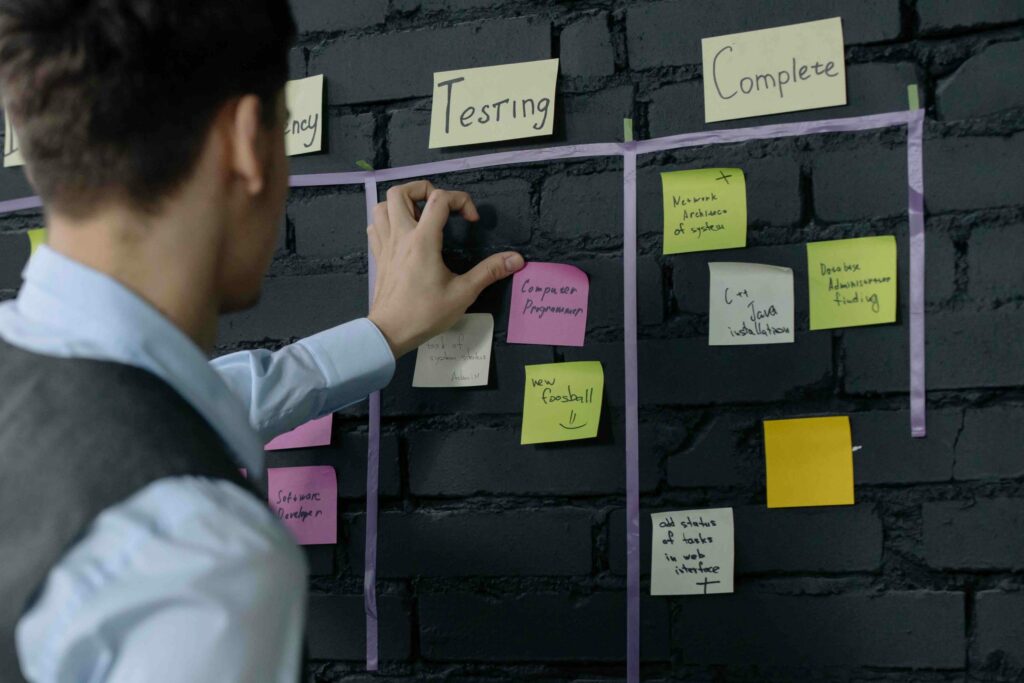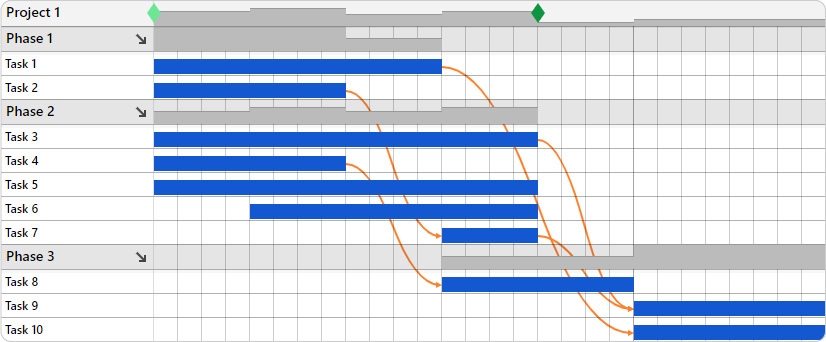Have you ever been a part of an agile project? If so, you know that the methodology can be extremely successful in keeping projects on track. If you haven’t had the opportunity to work on an agile project yet, you may be wondering what all the hype is about. Here we’ll discuss some of the most popular project management methodologies for agile projects and how they can help you stay organized and efficient. Whether you’re just starting out in your career or have been managing projects for years, we hope this information will be helpful to you!
What is the Agile Approach to Project Management?
Agile is an iterative, step-by-step approach to projects. As opposed to trying to deliver the whole project as a complete package, agile breaks up the project into smaller pieces, and reevaluates goals and deliverables at each step of the way. Working this way, change is not to be feared. In fact, it’s most welcome. Since at the end of the day it’s not only about having a finished product, but it’s about having a working product that everyone is happy with.
Agile is usually closely related to technology and software development. But the truth of the matter is, many industries have been able to benefit from it. Integrating agile projects into systematic approach, however can be another story. That’s why we’ve narrowed down 5 project management methodologies and compared how useful they are for agile projects.
Project Management Methodologies for Agile Projects
Here are a few methodologies that can be used for agile project management.
1. Waterfall
Waterfall project management is a traditional method for managing projects. It is characterized by its linear, sequential approach. In waterfall, each phase of the project is completed before moving on to the next phase. This makes it easy to track progress and identify potential problems early on.
While waterfall can be effective for some projects, it can also be inflexible and may not work well for agile projects. In an agile project, the requirements may change during the course of the project. This can make it difficult to track progress using a traditional waterfall approach.
How to use Waterfall?
If you’re considering using waterfall for an agile project, there are a few things to keep in mind:
- Be aware of the potential risks associated with using a waterfall approach for an agile project.
- Be prepared to adapt your waterfall project management methodology to accommodate the changing requirements of an agile project. Adding task dependencies can be helpful if you need to make changes, as you can see what exactly is affected when you adjust dates and task lengths.
- Make sure you have a clear understanding of the waterfall project management process before beginning your project.
By understanding the risks and challenges associated with using waterfall for an agile project, you can be better prepared to manage your project successfully.
2. Agile/Scrum

The Agile/Scrum project management methodology is a great option for agile projects. It’s lightweight and easy to use, and it helps keep your project on track. It’s a favorite project management type for web design, software and app development, and other technology fields. But this popularity has seeped its way into other industries as well.
That’s because this methodology is extremely flexible and can be adapted to a variety of project types. It’s also scalable, so it can be used for projects of all sizes.
To give you a quick overview, here’s how it works:
- The Agile/Scrum methodology is based on the principle of continuous improvement. Every sprint, or iteration, is an opportunity to learn and improve.
- The scrum master is responsible for keeping the project on track and ensuring that each team member is pulling their weight.
- The product owner is responsible for setting the direction for the project and ensuring that the team is working on the most important tasks.
- The team members are responsible for actually doing the work.
3. Kanban
Kanban is a flexible and popular project management methodology that can be used for agile projects. Based on the principles of lean manufacturing and its main goal is to help teams work more efficiently by eliminating waste and reducing cycle times.
Moreover, incorporating a Kaizen culture within your Kanban methodology can provide enhanced benefits. Embracing continuous improvement and respecting people are key aspects central to a Kaizen culture. This synergistic combination can be pivotal in driving efficiency and productivity in agile projects.
Kanban projects are typically divided into three phases:
- Planning phase – the team determines the scope of the project and creates a Kanban board to track progress.
- Execution phase – the team works on tasks and moves them through the Kanban board.
- The review phase – the team reviews the project to identify lessons learned and improve processes for future projects.
How to do Kanban planning?

Kanban can be used for any type of project, but it is especially well-suited for agile projects that are constantly changing and evolving. If you’re thinking about using Kanban for your next project, here are a few things to keep in mind
- Start with a small team – Kanban is best suited for smaller teams of 8-10 people. Trying to implement it with a larger team can be challenging and may lead to chaos.
- Use visualization – One of the key aspects of Kanban is visualization. This means creating a Kanban board that everyone on the team can see and using it to track progress.
- Limit work in progress – Another key principle of Kanban is to limit work in progress (WIP). This means that you should only have a certain number of tasks in progress at any given time. This helps to prevent bottlenecks and ensures that work is flowing smoothly through the system.
- Focus on continuous improvement – Kanban is all about continuous improvement. As your team works on projects, take time to review the process and identify ways to improve it. This can help you make future projects even more efficient.
Real Life Case Study
If your organization is interested in pursuing a lean manufacturing outlook, there’s more options than just Kanban. Sunstall are a US based and nationally recognized solar construction firm who have always taken a Kaizen Approach to how their company grows. In order to help them with their mission, they’ve employed Ganttic’s resource planner. With the resource-centric Gantt charts helping them increase them be more agile and efficient. CEO Helge Biernath had this to say:
“Different people from all over the company can look from different angles and get the most up to date information about their job…[ with the] planning tools are helping us to optimize the logistics between project locations, reducing waste and travel emissions.”
Read more about Sunstall in our case study.
4. Extreme Programming (XP)
If you’re looking for a project management methodology that is agile and focused on delivering results, then Extreme Programming (XP) could be the right fit for your team. XP is a popular choice for software development projects, and its key principles can be applied to other types of projects as well.
Some of the key features of XP include:
- a focus on delivering results quickly and efficiently
- flexible, adaptable approach to change
- strong focus on communication and collaboration
- centered on customer satisfaction
XP is a great way to get projects done quickly and efficiently, but it’s not the only option. For example if your project needs constant attention or has high risk involved then there are other options that might be better suited for you. That’s because XP is based on what we know now about delivery methods, such as pair programming, which can help decrease time spent bugs found per line of code worked by 50%.
If you think XP could be a good fit for your next project, talk to your team and see if they’re willing to give it a try. With the right team in place, XP can help you deliver amazing results.
5. Feature-Driven Development (FDD)
FDD is a project management methodology that focuses on delivering features or functionality to the customer. It is an agile approach that can be used in conjunction with other agile methods such as Scrum or Kanban.
FDD was first proposed by Peter Cauwels in 1998. The key principles of FDD are:
- Divide the project into features
- Model the features
- Plan by feature
- Build an executable prototype of the most important features
- Design by feature
- Test each feature before coding it
- Code the features in small, incremental steps
- Deploy the system frequently
- Collect feedback and course correct
FDD has been shown to be successful in delivering software projects on time and on budget. It is especially well suited for large, complex projects with many stakeholders.
It is no secret that FDD, like any other methodology has its own set of challenges and tradeoffs. However it’s important to note this approach only works best on projects with well-defined requirements which are understood by all parties involved in order for them be successful. There needs plenty discipline because without strict guidelines nothing will get done anyway so don’t shy away from tough discussions – embrace them instead.
Managing large, expensive IT projects is no picnic. So it can be helpful to learn from the mistakes of others. See our infographic of why IT projects fail and figure out how to course correct.
- Project management software – this will help you to create and track tasks, visualize progress and milestones, and keep all your team members on the same page. For agile projects, it’s important to see the next thing, so visual tools like Gantt charts and Kanban are must-haves in whichever software you go with.
- Communication tools – one of the most important keys to success for agile projects is good communication. There are a variety of tools available to help facilitate this, including Slack, Google Hangouts, and Zoom.
- Collaboration tools – for agile projects to run smoothly, it is essential that team members are able to collaborate effectively from wherever they are located. Especially since it’s common with agile teams to work from different corners of the world. There are a range of collaboration tools for these dispersed teams available, such as Slack, Trello and Google Docs, which can help teams to communicate and work together more effectively.
- Creativity tools – depending on your agile project’s end goal, it may be imperative to have some creative tools in your arsenal. There are a number of easy to use tools such as Canva, Explain Everything, or video editors such as VEED, all of which can help you to create professional-looking videos and images. For photos on the other hand, PicsArt is a great tool to give your photos a cartoon-style look.
Successful Agile Projects

There are a variety of project management methodologies available for agile projects, each with its own benefits and drawbacks. In this article, we’ve looked at five of the most popular approaches: Scrum, Kanban, Agile Unified Process, eXtreme Programming, and Feature-Driven Development. No matter which methodology you choose, there are a few tools that are essential for any agile project.
Since the point of agile projects is constant communication, iteration, and flexibility it’s key to incorporate the right software into your agile workflow. For a high level overview of your projects, resources, and tasks – Ganttic has you covered. Streamlined resource planning that fits comfortably amongst any workflow and methodology you decide to go with.
Book a free demo to learn more. Or sign up to see for yourself.